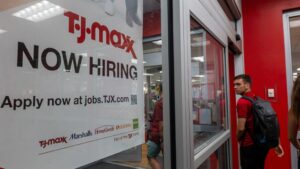Understanding the Upcoming Jobs Report: What It Means for the Economy
As we approach another crucial jobs report slated for release this Friday, the economic landscape remains tumultuous. Picture this: a pedestrian strolls past a “Hiring Now” sign outside a U-Haul store in San Rafael, California, emphasizing the urgency of the current labor market. But beneath this façade of opportunity lies a deeper uncertainty—one that could redefine the economic narrative moving forward.
At Extreme Investor Network, we believe that understanding these indicators isn’t just about numbers; it’s about the broader implications for investors, policymakers, and stakeholders in the economy.
The Anticipation of the Jobs Report
The Bureau of Labor Statistics (BLS) is expected to announce that nonfarm payrolls increased by 214,000 in November, a stark contrast to October’s dismal figure of just 12,000—marking the worst job growth since December 2020. This upcoming report is being heralded as pivotal, serving as the last comprehensive glimpse for the Federal Reserve before their policy meeting on December 17-18. Investors are banking on a quarter percentage point interest rate cut, but the job data will be a determining factor in this decision.
Kathy Jones, chief fixed income strategist at the Schwab Center for Financial Research, shares insights that the upcoming report should demonstrate a rebound from the disruptions caused by October’s challenges, including Hurricane Milton and the Boeing strike. Historical revisions to payroll reports may also play a role, as they have often been substantial in the post-COVID era.
The Fed’s Balancing Act
The Fed’s challenge is to steer policy amidst fluctuating inflation rates and an evolving labor market. With payroll gains averaging 128,000 new jobs per month and the unemployment rate inching up to 4.1%, the urgency to recalibrate their approach has never been greater. A slowing trend in nonfarm payrolls might not trigger alarm bells; instead, it could signal a more sustainable economic environment.
As Vincent Reinhart, former Fed official and current BNY economist, notes, the noise of fluctuations from disruptions can muddy the waters. However, a slow progression toward a trend rate of slightly above 100,000 jobs created monthly could be welcomed as a sign of stability.
A Closer Look at the Labor Market Landscape
Initial weekly unemployment insurance claims have held remarkably steady around 220,000. Yet the dynamics of the job market present a mixed picture. Although layoffs remain low, employers are exhibiting caution regarding future hiring, with a stronger preference for entry-level roles and skilled trades.
Interestingly, job openings saw an increase in October, but hiring rates declined, suggesting a hesitance among businesses to fully commit. This is a crucial consideration for investors, as these metrics could influence consumption patterns and, subsequently, economic growth trajectories.
The Fed’s recent "Beige Book" summary conveys a labor market that is subdued, with many firms refraining from increasing headcount. As the Fed deliberates over interest rate decisions in these uncertain times, the stability—or instability—of the labor market will be an essential factor.
What to Expect Moving Forward
The jobs report may not only yield insights into payroll gains and the unemployment rate, projected to nudge up to 4.2%, but it will also reflect broader economic sentiments. With average hourly earnings estimated to increase by 0.3% month-over-month and 3.9% year-over-year, any deviations from these expectations could signal shifts in inflationary pressures.
Our commitment at Extreme Investor Network lies in decoding these economic signals for our readers. As the labor market searches for balance amidst external pressures, it is crucial to remain vigilant. A steady labor market can alleviate inflationary concerns, enabling the Fed to manage growth effectively.
In conclusion, the upcoming jobs report holds the potential to not only inform policy direction but also shape investment strategies and economic outlooks. As we navigate these challenging waters, staying informed and adaptable remains crucial for any aspiring or seasoned investor. Keep an eye on our platform for insightful analyses and updates as we delve deeper into the implications of this employment data.

